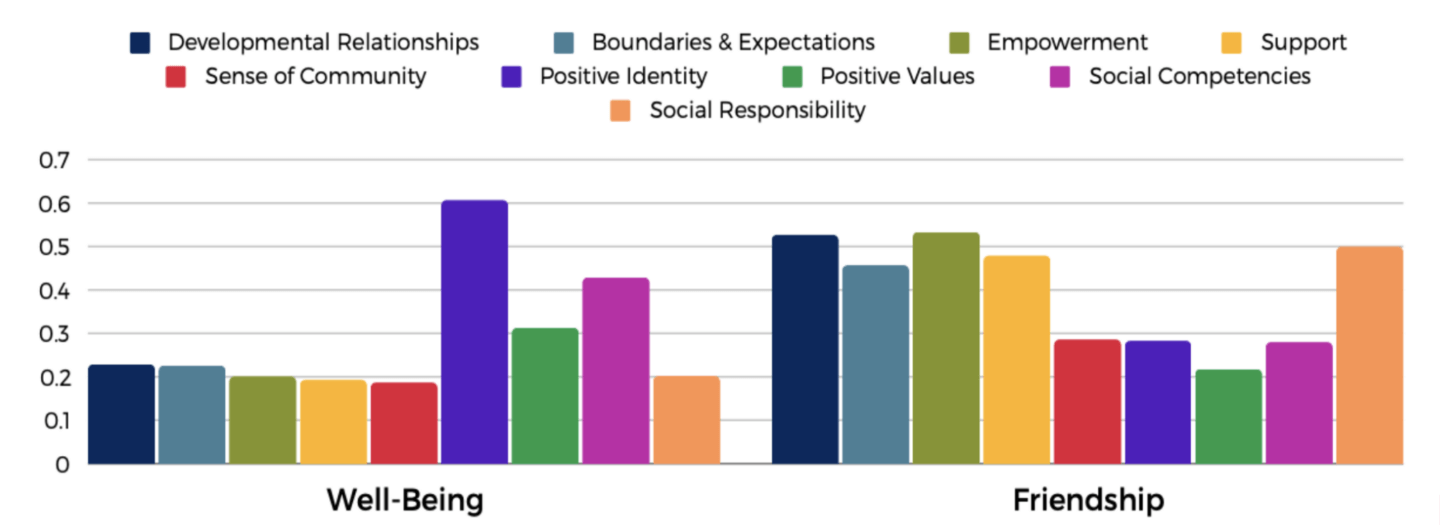Written by: Tommy Marzella, Katherine Ross, Ph.D., and Diane Hsieh, Ph.D.
For over a decade, The Trevor Project has operated TrevorSpace, an affirming, online community for LGBTQ+ young people between the ages of 13-24. TrevorSpace helps young people explore their identities, get peer advice, find peer support and joy, and make friends in a moderated community.
TrevorSpace is designed for young people to start or enter conversations around their identity and interests, including topics like mental health, gender identity, sexual orientation, coming out, as well as entertainment, games, debate, and more. With fewer than 40% of LGBTQ young people finding their home to be LGBTQ-affirming, TrevorSpace creates an opportunity for young people to find community and overcome the challenges and barriers that may exist when trying to access in-person support (i.e. transportation; safety; coming out before one is ready; lack of financial means, etc.).
The team behind TrevorSpace has invested in sophisticated trust and safety software to help us better protect the platform from harm and bad actors. But, beyond just keeping our users safe, we wanted to deeply explore and improve the value young people are getting on TrevorSpace within a Positive Youth Development (PYD) framework. If you’re unfamiliar with PYD, here’s a great definition:
Positive Youth Development (PYD) is an approach to youth development research and practice that emphasizes young people’s capacities and strengths (rather than their risks and deficits) and the importance of intentionally cultivating developmental relationships, experiences, and opportunities across all contexts of their lives in ways that nurture thriving and resilience, benefiting themselves, those around them, and society. When done correctly, this model helps young people experience positive, healthy, and thriving outcomes as they enter into adulthood.
Thankfully, a generous grant from The Annie E. Casey Foundation enabled our team to partner with Search Institute, a nonprofit organization with a 60+ year history of promoting PYD and advancing equity through evidenced-based research and practical solutions; with the goal of better understanding and exploring PYD on TrevorSpace. What is most exciting about this project is that, in most instances, PYD is a framework used in in-person settings. Given that TrevorSpace is an online, peer-to-peer networking site, we were thrilled to see what we could learn about it within the context of online spaces.
We began by conducting a comprehensive literature review to better understand what research was published around the strengths of LGBTQ+ young people. The bulk of social science research focused on the challenges LGBTQ+ young people face. Though generally accurate and consistent with other groups experiencing marginalization and systemic discrimination, these narratives are only part of the story (and fail to celebrate the strength and assets that LGBTQ+ young people possess). Furthermore, leading with the negative narrative – even when intended as an urgent call to action – too often has the unintended consequences of reinforcing harmful preconceptions and stereotypes. Overall, the literature review clearly pointed to a need to understand and uplift the lived experiences of LGBTQ+ young people from an asset-based, PYD perspective.
Overall, the literature review clearly pointed to a need to understand and uplift the lived experiences of LGBTQ+ young people from an asset-based, PYD perspective. This led to the formation of a Youth Leadership Team, composed of five TrevorSpace users, to help us better understand youth perspectives and design a survey we could administer to TrevorSpace users to receive more comprehensive input.
We opened up a survey for two weeks to our users to better understand how TrevorSpace may be supporting PYD, including current strengths, where we received data points from 600+ young people. We surveyed around two key areas:
- Developmental Assets (DA): The external supports, opportunities, and relationships as well as the internal skills, attitudes, and values young people need to grow up well and thrive.
- Development Relationships (DR): Meaningful, trustworthy, and close connections that young people have with supportive peers and adults that help them learn how to interact with and contribute to the world.
The surveys were modified from two valid and reliable tools developed by Search Institute, the Developmental Assets Profile (DAP; Leffert, Benson, & Scales, 1998) and the Developmental Relationships Survey (DRS; Pekel et al., 2019) to specify the relational target of interest to be people they interact with on TrevorSpace and the context of interest to be the TrevorSpace site/community. The traditional DAP and DR surveys examine relationships and strengths across multiple contexts including teachers/school, parenting adults/family, peers/social, and program leaders/community. Another important modification to point out is that we replaced two DAP scales for constructs that are more aligned with virtual spaces (and the information we were gathering via the Youth Leadership Team, listening sessions, and literature review).
Today, we’re proud to share three key findings to help us and others advance their work when it comes to online spaces for LGBTQ+ young people.
- Regular use of TrevorSpace (frequency) was associated with higher levels of most reported strengths: In a time when social media use is often deemed harmful to young people, we found that the frequency of use of TrevorSpace is correlated to higher developmental relationships; boundaries and expectations; empowerment; support; sense of community; positive values; social competencies; and social responsibility. Our team is extremely excited by this insight, as it shows that although social media comes with its challenges, it has the power (and is) making a positive impact on the lives of LGBTQ+ young people.
Although we want to explore this area in further detail, we know that social media connects
LGBTQ+ young people who otherwise may not know fellow LGBTQ+ young people like themselves. It shows them that people like them do exist and helps them develop an online sense of community that may not be present within their own communities. Like many communities, social norms are built together, helping LGBTQ+ young people increase developmental relationships, boundaries, and sense of belonging and ownership.
- There is a significant positive correlation between all strengths and our two major PYD outcomes (wellbeing and friendship): We examined the relationship between youth reported strengths (developmental relationships and developmental assets) and found a significant and positive correlation between all strengths and our two outcomes of interest (wellbeing and friendship). The correlation coefficients are graphed below to display the magnitude of the relation.

The correlations all being positive and significant means that the youth who reported greater developmental relationships and assets from TrevorSpace also tend to report better wellbeing and friendship. These results support the important strength and asset work already happening on TrevorSpace and how valuable it is to youth users’ positive development.
Notably, the magnitude of the relation between youth strengths and the outcome of friendship was bigger than the relation between youth strengths and the outcome of wellbeing (indicating that building these strengths on TrevorSpace is really important for friendship). Additionally, positive identity and social competencies seem to be particularly important contributors to youth-reported wellbeing. These are likely important targets for building support, as a primary interest for TrevorSpace is youth wellbeing.
- The highest ranking external asset is “sense of community,” while the highest ranking internal asset is “positive values.” TrevorSpace users were presented with a series of statements and a scale ranging from strongly agree to strongly disagree. Some highlights within these two categories include:
- 99% strongly agree or agree that they think it’s important to help other people
- 97% strongly agree or agree that they are developing respect for other people
- 94% strongly agree or agree that they take responsibility for what they do
- 93% strongly agree or agree that they care about what happens on TrevorSpace
- 89% strongly agree or agree that they are helping to make their community a better place
- 89% strongly agree or agree that they feel a sense of community at TrevorSpace
- 84% strong agree or agree that they are serving others in their community
Additionally, when it comes to developmental relationships, 89% of users strongly agreed or
agreed that people on TrevorSpace expressed care by showing them that they matter. 89% of users also agreed or strongly agreed that people on TrevorSpace share power by listening to their ideas and taking them seriously.
As our team continues phase two of this project, we will be working directly with the young people on TrevorSpace to help make sense of the data and implement solutions to better meet their needs. We’re thrilled at the leading indicators of success showing that online communities, especially communities designed for LGBTQ+ young people, have the power to help them experience positive, healthy, and thriving outcomes as they enter adulthood.
Disclaimer: This research was funded by The Annie E. Casey Foundation, Inc., and we thank them for their support; however, the findings and conclusions presented in this report are those of the author(s) alone, and do not necessarily reflect the opinions of the Foundation.


